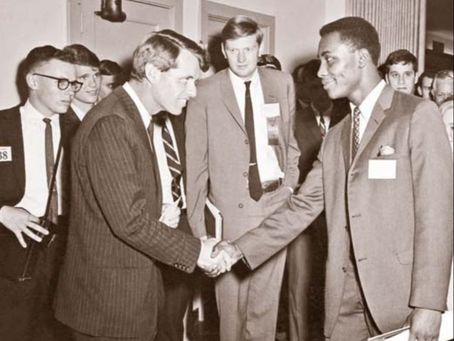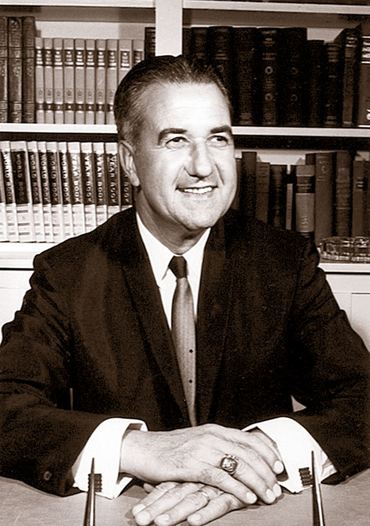In the summer of 1957, the Alabama Board of Trustees—seeking to replace Pres. Oliver Cromwell Carmichael, his presidency destroyed by the riots during Autherine Lucy’s admission—offered the job to Transylvania University Pres. Frank A. Rose. The thirty-seven-year-old Rose, a native of Meridian, Mississippi, had served on a commission exploring ways to desegregate Kentucky public schools. Rose, who resisted the initial search committee inquiries, accepted the presidency when told he was needed to facilitate the University’s desegregation.
Before moving to Tuscaloosa, Rose visited Gov. James E. Folsom, who told him it was time to desegregate the University. Rose’s friend Nelson Rockefeller recommended that Rose talk to a judge he served with on the board of trustees at Tuskegee Institute, a “real progressive” named George Wallace. When Rose spoke with Wallace in late 1957, he supported desegregating the University. Since John Patterson, the next governor, was not so inclined, Rose spent four years building alumni support and constructing twenty-five new buildings.
When Rose assumed the presidency in January 1958, he found administrators ready to help. In March 1956, Alabama Dean of Men Louis Corson, looking for an assistant dean, called John L. Blackburn, dean of men at Florida State University. Blackburn, who had successfully integrated males into what had been the Florida College for Women, was an outspoken advocate for racial integration. When Blackburn asked, “Why would I want to work at a place like Alabama?” Corson responded, “Given your concerns over racial justice, where else would you want to work?” In 1958, when Corson retired, Rose elevated Blackburn to the dean’s post. Most University administrators accepted the inevitability of desegregation; Blackburn sought it.
When Frank A. Rose came to Tuscaloosa from Kentucky, he found administrators willing and able to end segregation at the University of Alabama. Among them were Dean of Men John L. Blackburn, and Vice President J. Jefferson Bennett.
The violence at Ole Miss grabbed the attention of Frank Rose, members of the administration, and Tuscaloosa civic and business leaders as well as some student leaders like Melvin Meyer, editor of the Crimson-White, which responded with an editorial titled, “A Bell Rang” noting, “Bias is a force that strikes one and all…. We lost something American in Oxford this week.” That the United Klans of America was headquartered in downtown Tuscaloosa added a sense of urgency. When the Klan threatened Meyer, although he was not the author of the editorial, Rose hired private detectives to protect him.
Rose, meanwhile, focused on keeping the University safe. In November, he called a faculty meeting in the Morgan Hall auditorium where, after a brief discussion, the faculty passed a resolution to affirm, “Learning can flourish only in a peaceful environment.” Additionally, Blackburn and Healy secured support of student leaders representing groups from the Student Government Association and Associated Women Students to the Inter-fraternity Council and Baptist Student Union.
Rose also needed backing from Tuscaloosa’s civic and business elites. George LeMaister, law professor turned bank president, wary that Governor-elect Wallace’s resistance to court-ordered desegregation might imperil economic prospects, spoke out at a November meeting of the Tuscaloosa Civitan Club. “No state official,” he declared, “has the right to put himself above the law, and that includes the governor.” His remarks received a standing ovation.
On May 28, LeMaistre and realtor Harry Pritchett called a meeting of 242 prominent Tuscaloosans, including Klan Imperial Wizard Robert M. Shelton. After a heated discussion, 212 civic leaders signed a petition urging Wallace to oppose desegregation in the courts and not impose himself on the University campus. Shelton refused to sign, stating that the petition, “doesn’t amount to a hill of beans.” Civic and business leaders’ support for peaceful desegregation reflected their interest in financial growth, not racial integration.
The morning after attending a late May meeting of Washington’s National Capital Chapter of the Alabama Alumni Association, Rose and Bennett had breakfast with Rose’s close friend Atty. Gen. Robert F. Kennedy. Bennett told Kennedy that should federal military intervention be required, the president should federalize the five hundred Alabama National Guardsmen Wallace planned to deploy to Tuscaloosa rather than call in US Army troops. Bennett explained that Alabama Guardsmen, being white, would be less provocative.
After breakfast Kennedy escorted Rose and Bennett to the White House to run the idea by the president. An agitated President Kennedy greeted the trio following a meeting with Soviet Ambassador Anatoly Dobrynin. Kennedy, after fuming that the Soviets weren’t removing missiles from Cuba as agreed to in October 1962, told Rose he feared another strategic confrontation and couldn’t risk “potentially divisive riots in Alabama.” When Kennedy suggested postponing the desegregation for at least a year, Rose promised there would be no riots, stating, “Mr. President, not even Wallace wants trouble.” After Rose detailed the precautions taken to prevent violence, he warned any delay might embolden “the worst elements in the state.” The President looked to his brother, asking, “Bobby, what do you say?” Bobby replied, “If Frank says ‘no riots,’ you can bank on it.” Accordingly, JFK approved the June 11, 1963, plans for desegregating the University of Alabama.
On that date, Vivian J. Malone and James A. Hood walked through the open doors at Foster Auditorium. The University of Alabama entered a new era of growth under the aegis of academic excellence envisioned by Frank Rose. Because good people at the Capstone and in Tuscaloosa worked to achieve a noble goal, civilized behavior triumphed when, otherwise, mayhem might have reigned.
This feature was previously published in Issue 108, Spring 2013.
About the Author
Earl Tilford, a 1968 graduate of the University of Alabama, earned his doctorate at George Washington University. This article is drawn from his forthcoming book, Turning the Tide: The University of Alabama in the 1960s (University of Alabama Press, 2014).


 RSS Feed
RSS Feed